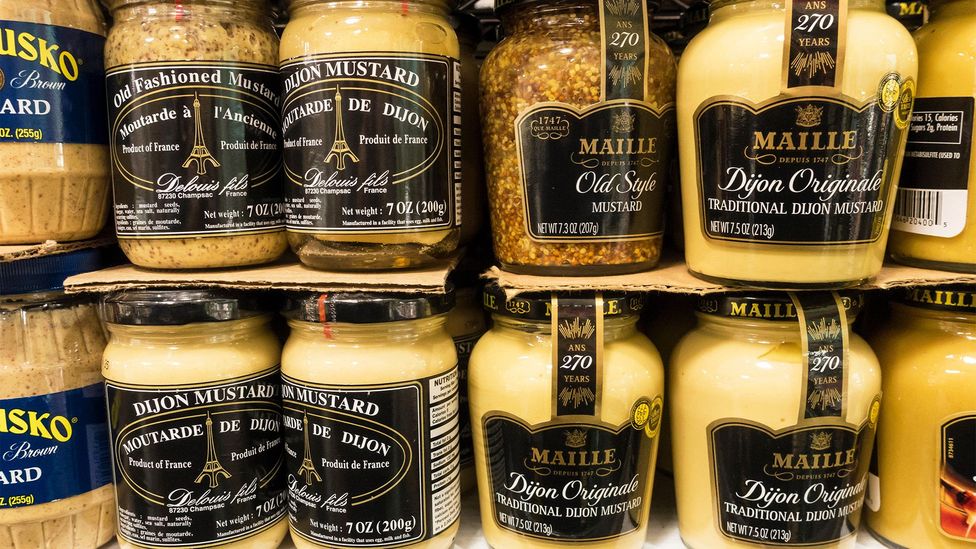
Take a wander down any condiment aisle in France these days, and you'll notice a pervasive absence between la mayo and le ketchup. Since this May, France has faced a widespread dearth of Dijon mustard, leading one French resident to advertise two jars for sale to the tune of €6,000 or about £5,000 (since revealed to be merely in jest). The shortage has incited expats (this author included) to not-at-all-jokingly smuggle squeeze bottles of Mailleback into the country from places like the US to get their fix, while author and Paris resident David Lebovitz even resorted to hunting his jars down at a local gardening store, of all places.
While French news outlets wasted no time in attributing the shortage to the war in Ukraine, the real story is a whole lot spicier than that.
Omnipresent on French tables, Dijon mustard, made by combining brown mustard seeds with white wine, is a beloved condiment that provides a counterpoint to rich, hearty dishes thanks to its acidity and heat. It's the perfect accompaniment to a slice of crisp-skinned roast chicken, the ideal way to jazz up a simple ham-and-butter sandwich and an essential ingredient in homemade mayonnaise.
That the condiment is so anchored in France's Burgundy region – of which Dijon is the capital city – is thanks to the historical co-planting of brown mustard seeds with the region's renowned grapevines, a practice introduced by the Ancient Romans to provide the vines with essential nutrients like phosphorous. Monks continued to cultivate mustard in this fashion for centuries, and, in 1752, the link between Dijon and mustard was cemented thanks to Dijon local Jean Naigeon, who married the seeds, not with vinegar, but with verjuice – the juice of unripe wine grapes historically used to add a pleasantly sour flavour to recipes in regions inhospitable to citrus.
Dijon mustard stands out from other mustards on the market for its subtle, balanced flavour. Packing more heat than American yellow mustard but less than powerful Chinese mustard or Bavarian senf, it capitalises on the pungency of the mustard seed by marrying it with the pleasant acidity of local Burgundian verjuice or, in most contemporary iterations, white wine.
But the truth is that despite its historical link the to the region, Dijon mustard has been delocalised for quite some time.
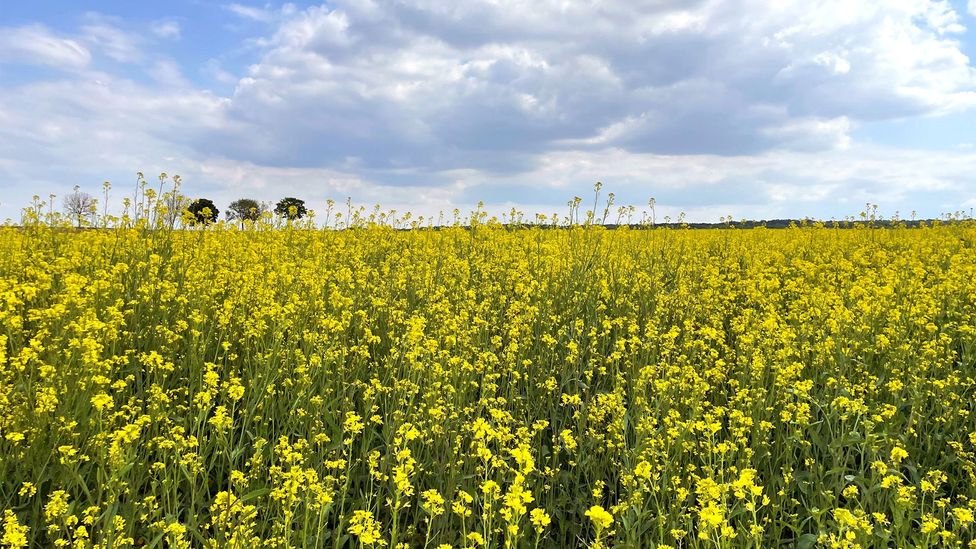
Historically, mustard seeds have been co-planted with Burgundy's renowned grapevines (Credit: Reine de Dijon)
After Burgundian farmers largely abandoned mustard cultivation in favour of higher-paying crops decades ago, moutardiers (mustard makers) began looking further afield for the tiny seed at the root of the condiment that launched 1,000 "Pardon me, sir" jokes. Their mustard seed needs were chiefly met by Canada, which produces about 80% of the world's supply. But this winter, Canadian-grown mustard also dried up, when, after several years of declining production had reduced stores, dry summer weather obliterated the Canadian crop, sending mustard seed prices skyrocketing threefold.
Though the shortage was not caused by the Russian invasion of Ukraine, it was exacerbated by it, impacting Dijon mustard makers "indirectly", according to Luc Vandermaesen, CEO of mustard producer Reine de Dijon. Rather than the brown seeds required for Dijon, Ukraine predominantly produces the white variety used in yellow and English mustard. Given the conflict, producers less tied to specific mustard varieties turned to Canada's already meagre supply, intensifying the shortage.
Inadvertently, this all shed new light on the discrepancy between the name "Dijon mustard" and where it's made. After all, unlike Champagne or Roquefort, the "Dijon" in Dijon mustard refers to a specific recipe and not to a geographic region protected by an Appellation d'Origine Contrôlée (AOC) or Appellation d'Origine Protégée (AOP) designation, which regulate products like wine, cheese and even lentils with an iron fist.
"There are no rules keeping the production of Dijon mustard in [the city of] Dijon," said Sophie Mauriange of the Institut National de l'Origine et de la Qualité (INAO), the governing board that controls the AOC and AOP labels in France. "You can make it anywhere in the world."
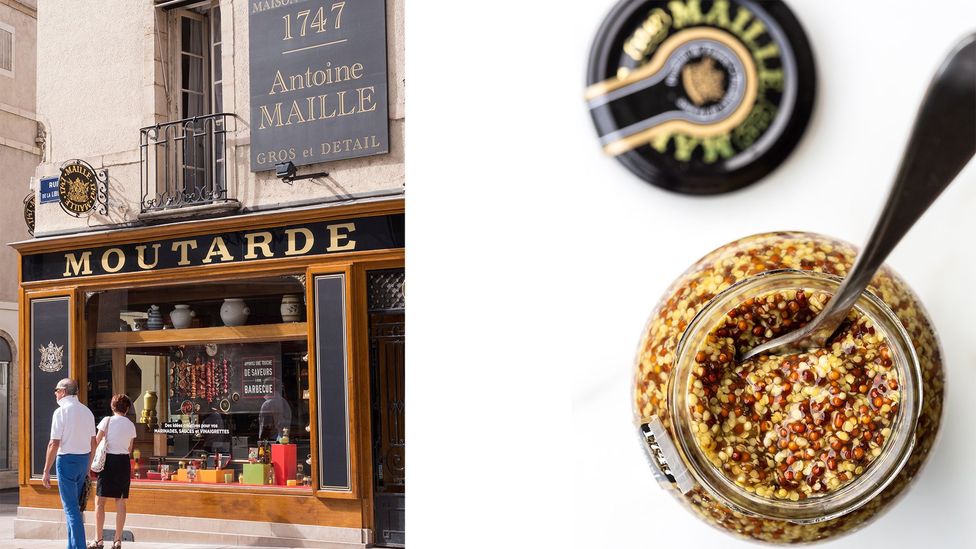
Maille closed its Dijon factory, moving production to Chevigny-Saint-Sauveur (Credit: CW Images/anna.q/Alamy)
And they do. Grey-Poupon, created in Dijon by Maurice Grey and Auguste Poupon in 1866 (and the preferred mustard of American hip-hop artists), has been made in the US since the 1940s. And in 2009, nine years after its purchase by Unilever, France's biggest Dijon producer, Amora-Maille (which makes Maille mustard), closed its Dijon factory, moving production to the nearby commune of Chevigny-Saint-Sauveur.
"As far as we know," said Mauriange, "there is almost no production of mustard in Dijon itself, save a very small amount at [La Moutarderie] Fallot's Dijon shop." (The artisanal producer has long made the bulk of its mustard at its factory in the nearby town of Beaune, where it was founded in 1840, and only opened its Dijon boutique, complete with a small, on-site workshop, in 2014.)
The truth is that while Dijon is in the mustard's name, the product is – and always has been – rooted in the city's surrounding countryside, where mustard production flourished in the decades that followed the condiment's 1752 invention. Charcoal producers would sow mustard seeds in fields filled with coal residue, a natural fertiliser, and the resulting seeds, explained Marc Désarménien, CEO and third generation head of La Moutarderie Fallot, were sold to master moutardiers in Dijon or Beaune.
"They had organised into a cooperative, at the time," Désarménen said of the local master moutardiers, of which there were already 33 in the early 19th Century. "So, there was what I would call a fairly powerful, fairly strong mustard industry."
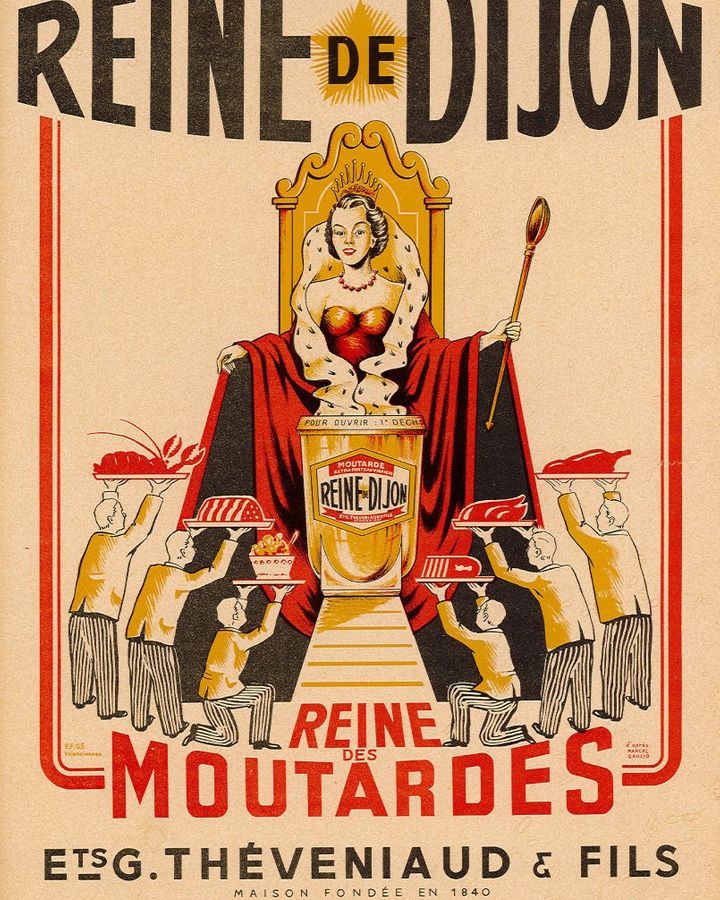
Reine de Dijon is one of France's major mustard producers (Credit: Reine de Dijon)
The decline of truly local mustard nevertheless began nearly a century ago: when Désarménien's grandfather purchased Fallot in 1928, he relied on "French mustard seeds, but not only", said Désarménien. "He needed to source seeds in other French regions and in other European countries in order to have a stable, high-quality product."
After World War Two, Burgundian farmers turned their back on the little mustard seed in favour of producing other crops, notably rapeseed for cooking oil and animal feed, which garnered them better pay thanks to government subsidies. By the 1980s, Mauriange said, "almost all mustard production was made with seeds imported from Canada."
The Association des Producteurs de Graines de Moutarde, an association of mustard growers founded in 1997, couldn't have existed even a decade earlier, when low demand for local seeds meant that production of Burgundian mustard had, according to its head Laure Ohleyer, "practically disappeared". But Burgundian mustard seeds began to experience a quiet renaissance in the '90s, thanks in large part to Unilever.
"They wanted to re-localise production," Ohleyer said of Amora-Maille's parent company. "And that's how it all began."
In recent years, thanks to demand from mustard producers, Burgundian farmers grew some 5,000 tons of mustard seeds annually – a portion of which have had an even more illustrious destiny than simple Dijon mustard.
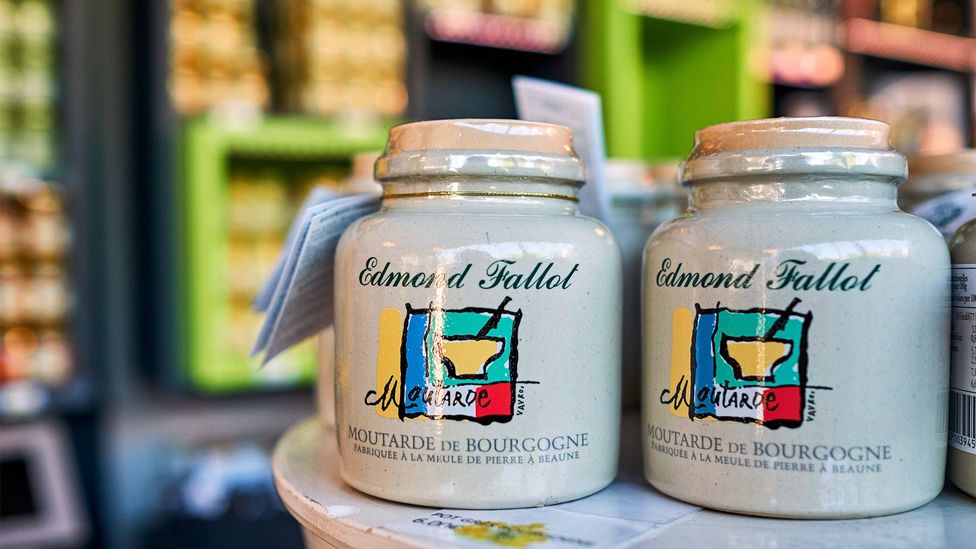
Edmond Fallot makes mustard within the IGP called Moutarde de Bourgogne (Credit: Tuul and Bruno Morandi/Alamy)
As French producers of Camembert learned in the '80s, it's nearly impossible to protect a product's geographic origin retroactively. But in the early 2000s, some mustard producers sought to take better advantage of the newly blossoming mustard seed industry and rekindle the notion of tying it to the local terroir. In 2009, they established an Indication Géographique Protégée (IGP) – a protected label similar to the AOP, but with fewer constraints. And while Dijon certainly gets more name recognition, it is this IGP – called Moutarde de Bourgogne – that actually means something: that the mustard is made in the Burgundy region with Burgundian seeds and Burgundian wine.
The IGP endeavour was spearheaded in large part by La Moutarderie Fallot's Désarménien, who Mauriange cited as "the most active in the request for recognition of the IGP". Indeed, of the five large mustard producers sourcing their mustard seeds from the mustard growers' association, Fallot is the only one that is making the entirety of its mustard within the IGP.
While Dijon certainly gets more name recognition, it is this IGP – called Moutarde de Bourgogne – that actually means something
For Désarménien, localising production was essential to maintaining the values of his artisanal business, which still stone-grinds its seeds at low temperature to maintain a slightly grainier texture and a fuller flavour. Of course, if Fallot can use exclusively Burgundian seeds, it's in large part because the company is far smaller than the four other mustard producers (Amora-Maille, Reine de Dijon, Européenne des Condiments and Charbonneaux-Brabant) sourcing at least some of their seeds from the association's producers.
The four others, Désarménien said, are responsible for about 80 to 90% of all French Dijon mustard production, with Fallot representing about 5% of the total local mustard market. Reine de Dijon's Vandermaesen said that less than 1% of his production is currently in the IGP, in part due to the price of the Burgundian white wine required. "But [this percentage] is growing," he said.
Or it was.
Of late, climate change and resulting infestations of mustard-loving meligethes (a type of pollen beetle) have halted – and even reversed – the growth of the local mustard market. And while pesticides were long the first line of defence, widespread insecticide resistance – not to mention the European Union's increasing stringency regarding chemical pesticides – has made it more difficult for growers to control these types of problems and bounce back.
"Until now, industrial producers were buying more and more from us each year," Ohleyer said. "But production can't keep up." Despite the demand, she said, Burgundian seeds currently represent only 20-30% of the supply.
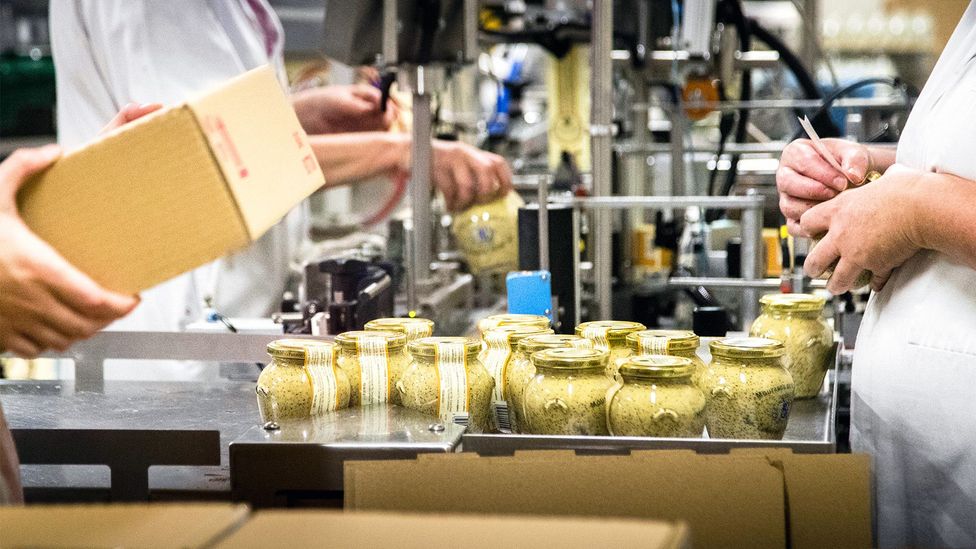
La Moutarderie Fallot represents about 5% of the total local mustard market in France (Credit: Georg Berg/Alamy)
For Mauriange, while these issues have certainly caused short-term problems for the mustard industry, there may be a silver lining to the recent shortage.
"This project had been facing climate challenges these last few years, which discouraged a lot of farmers," she said, noting, nevertheless, that a rise in prices for seeds following the shortage "has rekindled the dynamic" and encouraged farmers to devote themselves ever more diligently to successful production of this now-scarce crop.
For Désarménien, the answer may indeed be found in the rich history of the region.
"Our ancestors had growing methods that allowed them to limit these eventualities – insects and the like," said Désarménien. "Today, we're more in this mindset: of learning how we can move beyond chemicals to produce crops that may not be organic yet, but that are sustainable, if you like. That's our goal."
While "Dijon mustard" will likely never refer to a truly local product again, Moutarde de Bourgogne seems destined to develop its own reputation: not the connotations of grandeur or luxury Dijon producers have long capitalized on, but rather of sustainability and terroir.
And, if this year's harvest is any indication, the times seem to finally be changing for the little Burgundian mustard seed. Burgundian mustard growers brought in yields 50% higher than last year's, exceeding even the historic precedent set in 2016, French news outlet 20 Minutes reported in late July. As a result, moutardiers expect to be able to restock the condiment shelves this November – just in time to add tangy, spicy flavour to France's most beloved autumnal dishes.
No comments:
Post a Comment